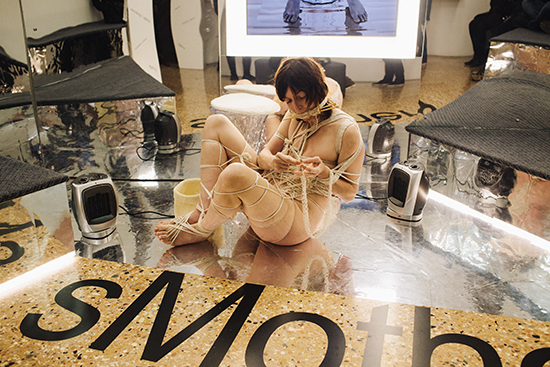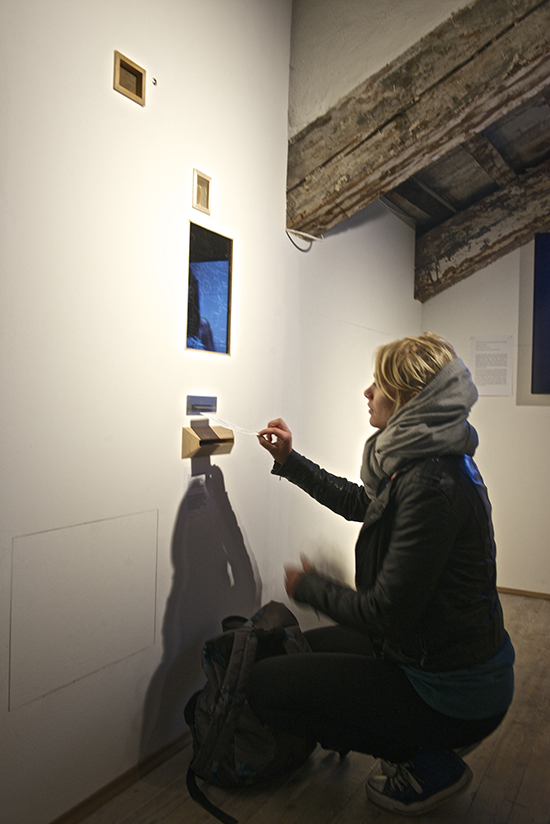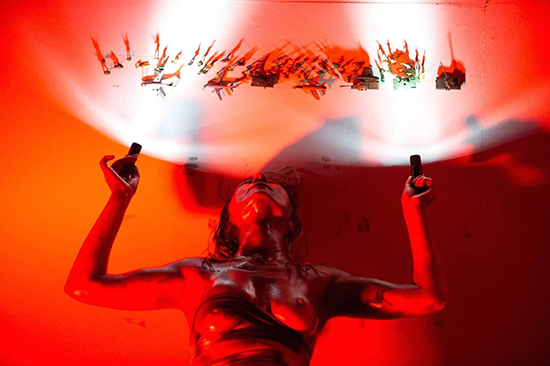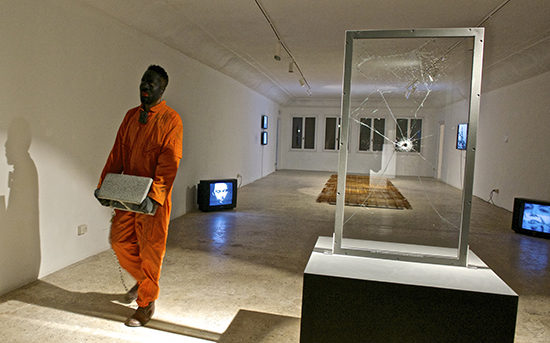Shifting gravity’s centre
Julie Vulcan: Venice International Performance Art Week

Casey Jenkins, sMother, Venice Performance Art Week 2016
photo Caterina Ragg
Casey Jenkins, sMother, Venice Performance Art Week 2016
In December 2016 I travelled to Italy to attend the Venice International Performance Art Week. The ambitious event brought together an extraordinary daily program of live works, an exhibition and panels with which to generate dynamic discussion and pedagogical platforms. Held biannually over the past six years, it is an international drawcard for performance art makers, curators, cultural operators and audiences alike, to gather for a week that is as much think tank as aesthetic experience.
2016’s Fragile Body-Material Body concluded a trilogy conceived by German artist duo VestAndPage. The curators are dedicated to representing diversity in cultural practice and to hosting a space where groundbreaking and established artists mix with mid and early career performers in a generous and impartial environment. There is an expectation for all artists to attend the whole of the week-long event. This year, seminal artists Stelarc, Orlan, Franko B, Marcel Antúnez Roca (a founding member of La Fura Dels Baus) and Antonio Manuel (Brazil) gave platform presentations to an absorbed crowd. Each iteration has seen Australian artists bringing new approaches and ideas to the mix. In 2014 Leisa Shelton Fragment 31 came on board as a co-curator and in 2016 presented artists Casey Jenkins, James McAllister and Stelarc alongside the UK artist and In Between Time Festival director Helen Cole.
Casey Jenkins, sMother
The room in which Casey Jenkins quietly performs sMother each day is strangely like a contemporary shrine. The architectural space plays into a reading that resonates with religious signifiers. Flanked by mirrors, Jenkins sits on a small clear plastic faceted stool which mimics cut glass. Behind is a life-size video portrait rendered iconic by its fluorescent light frame. Intentional or not, these quasi-religious references reinforce the artist’s sense of enquiry.
This durational performance is the final in a trilogy exploring how society preserves “absurd gender roles” and reinforces expectations of women perceived to be “of child-bearing age.” Over the week, Jenkins calmly knits a constrictive bind from yarn emerging from the vagina. Woollen knits, often associated with nurture and warmth, here take on a more insidious role, restricting and hobbling the artist’s body as the length of the narrow scarf increases each day. Manual Zabel’s soundscape adds to the sense of menace.
Positioned on either side of the room, resembling altar candles, are two pedestals, each with six red buttons. The audience can choose to activate these and in doing so their devotional action unleashes a volley of recorded public commentary. Patronising, opinionated and judgmental, it serves to remind us how we can all be complicit in the collective controlling of women’s bodies. Jenkins silently and stoically absorbs the relentless psychological barrage in this, the more precarious and disturbing part of the performance. The work’s religious overtones are made more apparent with the inclusion of the particularly oppressive and dogmatic voice of a conservative evangelist. Combining these overt commentaries with subtle activities, Jenkins reminds us that we still have a long way to go if we are to unbind deeply held expectations of the female body.

James McAllister, (utter) Oratorio, Venice Performance Art Week 2016
photo Edward Smith
James McAllister, (utter) Oratorio, Venice Performance Art Week 2016
James McAllister, (utter) Oratorio
In contrast, James McAllister occupies a constructed architectural space in which the performing body is so subtly present as to be almost invisible. Situated in an exhibition space away from the first floor performance galleries, (utter) Oratorio comprises a false wall in which a number of apertures have been inserted: a frosted rectangular window; a perforated masonite slide box; a small display box containing the smoothly contoured, used soap bar; a peep hole; and a letter box. McAllister refers to the functioning of his deceptively understated work as “a strategy for the soft architecture of human transaction.”
On numerous visits to the site, I witnessed subtle changes similar to the shifting landscape of a domestic space: the soap bar had altered; the slide box was open. Once, the small frosted window played host to a shadowy figure. I watched mesmerised as the grey-blue light blurred on contact with the palest skin: a cheek, a lip, an eye-socket, a hand. One moment I felt as if I was looking into an underwater abyss, the next a ghostly threshold. As with sMother there is an offer to actively engage, however in McAllister’s work it comes in the form of exchange. Via the letter-box, visitors post an item and a minute later receive a signed and stamped receipt describing the item delivered, the location, the date and the transaction number. On the final day I returned to this whispering-wall of sorts to find a gallery of tickets, photos, pictures and messages scrawled on postcards, pieces of paper, shopping receipts. The past week had been transformed into an archive of human interaction reaching through a literal and metaphorical barrier in an effort to connect.

Anna Kosarewska, Redirecting through, Venice Performance Art Week, 2016
photo Alexandre Harbaugh
Anna Kosarewska, Redirecting through, Venice Performance Art Week, 2016
Anna Kosarewska, Redirecting through
Barriers and borders manifest in a number of works this year, made more urgent in light of the current global socio-political landscape. Ukrainian artist Anna Kosarewska’s Redirecting through, performed across three days, could be seen as a triptych exploring inheritance, invasion and survival. On the first day, Kosarewska sits on a pedestal, her lap and head covered with a traditional embroidered fabric. Carefully and serenely she picks out a pearl, holds it for a moment and then either drops it or chooses to delicately sew it to the skin of her décolletage. A gas mask hangs ominously on the wall.
On the second day, this composed space is replaced by a more menacing one. Illuminated by the light from a looped geometric video projection, reminiscent of 20th century socialist design, a naked Kosarewska prowls the space to driving, repetitive music. At one point she traverses the room, slowly guiding torches across her body. Reminiscent of searchlights, they take on a sinister tone, seeming to probe deep beyond the barrier of the artist’s skin. References to war are evident in props such as toy soldiers and tanks. Pinned to the walls these cast distorted shadows generated from Kosarewska’s handheld flashlights.
On day three there is a return to a state of repose. Beneath two photographs, a long bolt of light cloth drops from the wall and unravels toward Kosarewska, shrouding her supine body on its low-lying gold podium. A mask of sprouting seeds covers her face and similar seeds are embedded in the cloth close to the wall. Renewal is evident in this image and I can’t help thinking about the opportunity to seed possible futures predicated on the acknowledgment of cultural inheritance and the effects of war. Kosarewska’s journey over the past three days has directed my attention to various states of instability—personal, cultural and national—and I am reminded that we must all take responsibility for the consequences of manufacturing borders across all three.

PREACH R SUN, For Whites Only, Venice Performance Art Week 2016
photo Edward Smith
PREACH R SUN, For Whites Only, Venice Performance Art Week 2016
PREACH R SUN, For Whites Only
This notion is echoed in PREACH R SUN’s performance epic, For Whites Only, which makes explicit the incredibly personal effects of racism accrued when crossing borders and experienced via cultural artefacts. From the moment he crossed from the USA to enter the EU the artist donned an orange boiler suit with the work’s title printed on the back. Once in Venice he was manacled to a cinder block which constantly accompanied him until his performance on the sixth night of the festival. Evoking a black evangelical preacher, he challenged and harangued the audience, repeating, “White Guilt, Black Shame.”
Welcoming us to the “auction block,” PREACH R SUN painted his dark skin to an extreme black, asking us if he was beautiful. As he cried out to Jesus for salvation, we watched with him cut-up porn movies eroticising black males in submissive roles to white males. Tensions rose notably when a woman in the audience intervened by taking hold of the staple gun the artist was using to affix fake money to his body. He responded by exclaiming that the work was real and not a performance and that no intervention could save him.
At the work’s penultimate point, working with images of a crucified and sacrificial black man, he implored us to acknowledge his humanity by repeating the words: “I am a man!” At first defiant, this repetition moved from anger to plain statement and concluded in a heartrending supplication. At the end, a visibly emotional PREACH R SUN deftly shifted the mood, asking who would share his burden. One by one, audience members passed the cinder block out of the space, down the stairs and into the courtyard, where it was smashed. A symbolic action heavily charged with the intensity of the last 90 minutes, it served as a potent reminder of how we must take steps to change the ways we unconsciously reinforce privilege and racism.
Over 50 artists performed across the eight days of Performance Art Week. It is impossible to convey the high calibre, dedication, depth of inquiry and generosity of each. There is more I would like to write about: the panels, the exhibition rooms; the late night artist dinners; but for now, know that we laughed, we cried, we squirmed and we were entranced. But most of all we celebrated a brilliant and diverse international community.
–
The Venice International Performance Art Week, 10–17 Dec 2016
The Venice International Performance Art Week and VestAndPage publish limited edition post-event hard cover catalogues documenting the exhibition and live performances, with essays on performance art-related issues by international scholars. 2012 and 2014 editions are now available. They include documentation of performances by Australian artists Jill Orr, Barbara Campbell, Sarah-Jane Norman and Julie Vulcan.
Julie Vulcan is a Sydney-based artist and writer best known for her durational performance works (Squidsolo, RIMA; Drift). In 2014 she performed at the Venice International Performance Art Week and attended the 2016 iteration as a writer and respondent with the support of the Australia Council for the Arts.
RealTime issue #137 Feb-March 2017






